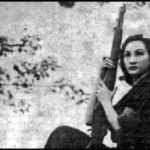Quote:
We wanted lasting peace, true democracy and justice. But after only a few months we had to realise that our hopes had not been fulfilled. Therefore we returned to the mountains to continue the struggle for the liberation of our country.
Source:
Rheinisches JournalistInnenbüro & Recherche International e.V. (2008): 100f.
Author Bio:
Remedios Gomez-Paraiso (1919-2014) was a commander of the anti-Japanese Hukbalahap People's Liberation Army in the Philippines during World War II. Here about the "liberation" and reoccupation of the Philippines by the USA in 1944.
Context:
 The Philippines was a Spanish colony from 1571 until, as an outcome of anti-colonial liberation struggle, it declared independence in 1898. However, its independence was not recognised, and in the ensuing Philippine-American War of 1899 to 1902, a fifth of the population lost their lives. The islands then became a US colony until 1942 when they were occupied by Japanese troops. The Anti-Japanese People's Liberation Army was the largest resistance movement in the Philippines and consisted of 30,000 fighters and 70,000 reservists. They collaborated with the US against the Japanese, but were a left-wing partisan group opposed to US colonial rule. According to writer Ricardo Trota Jose, 80% of Filipinos were either in the resistance or supported it ‘One million Filipinos fought in various guerrilla movements. The only problem was: there were not enough weapons. For twenty volunteers who went to the partisans, only one rifle came’ (rjb & ri 2008). The Philippines gained independence in 1946, but a US-friendly government was then installed. It was only in 1990, under President Corazon Aquino, that resistance fighters were finally recognised as such (Rheinisches Journalistenbüro & Recherche International 2008: 100f.).
The Philippines was a Spanish colony from 1571 until, as an outcome of anti-colonial liberation struggle, it declared independence in 1898. However, its independence was not recognised, and in the ensuing Philippine-American War of 1899 to 1902, a fifth of the population lost their lives. The islands then became a US colony until 1942 when they were occupied by Japanese troops. The Anti-Japanese People's Liberation Army was the largest resistance movement in the Philippines and consisted of 30,000 fighters and 70,000 reservists. They collaborated with the US against the Japanese, but were a left-wing partisan group opposed to US colonial rule. According to writer Ricardo Trota Jose, 80% of Filipinos were either in the resistance or supported it ‘One million Filipinos fought in various guerrilla movements. The only problem was: there were not enough weapons. For twenty volunteers who went to the partisans, only one rifle came’ (rjb & ri 2008). The Philippines gained independence in 1946, but a US-friendly government was then installed. It was only in 1990, under President Corazon Aquino, that resistance fighters were finally recognised as such (Rheinisches Journalistenbüro & Recherche International 2008: 100f.).Further Reading:
*Rheinisches JournalistInnenbüro & Recherche International e.V. (2008): Die dritte Welt im zweiten Weltkrieg. Unterrichtsmaterialien zu einem vergessenen Kapitel der Geschichte.
Year:
1944